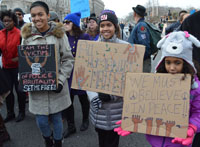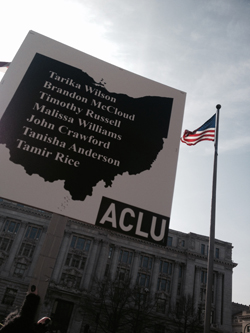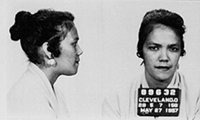News & Commentary
Seeking the Right Questions On Race and Criminal Justice Reform
Photograph courtesy of Rachel Woods You will never find a solution without asking the right questions. Last week, Columbus hosted two different gatherings intended to address tensions between communities of color and law enforcement. While part of the same conversation, both brought different people and different approaches to find solutions. At the end of the day, they raised important questions around race and criminal justice reform. Wednesday: A National Initiative On Wednesday, the first meeting of the National Initiative on Building Community Trust and Justice convened at Capital Law School. Funded by a U.S. Department of Justice grant, this program attempts to develop concrete proposals for fostering racial reconciliation, recognizing implicit bias, and advancing procedural justice. Representatives from the DOJ, criminal justice researchers, and policy experts are traveling the country to engage in dialogue with community members. The purpose and goals of the initiative offered an encouraging sign that the outrage felt across the nation has been heard at the highest levels of government. Demands from the streets, churches, and community centers across the country have secured a place on the federal agenda. The speakers expressed their optimism about the program and their desire to hear what local communities have to say. But as the third panel of experts took their places in the front of the room, it seemed that the time allotted for outside voices had been a secondary consideration. Thursday: People First On Thursday, charter buses lined up near the Ohio Statehouse as people from across Ohio came together for the People First Assembly. This event, coordinated by the Ohio Organizing Collaborative, brought together community members and local leaders to tell their stories about the criminal justice system to the offices of their state representatives.

An End to Highway Robbery? Not Quite Yet
Fourth Amendment, U.S. Constitution
It’s one of the most highly praised constitutional rights in the world. In reality, however, the Fourth Amendment has been severely diluted. A good example is related to seizure of assets—cash and property like vehicles and real estate—without warrants or criminal charges.
Inequitable Justice
Until a recent cha

Black Lives Matter: Policing, Indifference, and Women of Color
Photograph courtesy of Rachel Woods

Sunset at the Statehouse
As the end of the year approaches, what went on in the final days of the 130th Ohio General Assembly? When last I wrote about the Ohio legislature’s “lame duck” session, I provided updates on the so-called Heartbeat Bill and the lethal injection bill. From a civil liberties perspective, these were the two most visible bills but not the only ones. Here is a final update on what the Ohio General Assembly did in the waning days of this session: Heartbeat Bill House Bill 248 made its way to the House floor for a vote. However, this extreme bill, which would outlaw abortions before many women even realize they are pregnant, went down to defeat with 11 Republicans joining in to vote against it. Lethal Injection Secrecy Our members responded in large numbers when we asked them to contact OGA members in opposition to House Bill 663. As it wound its way through the Statehouse, the bill did improve via numerous amendments, but the fundamental problems that caused us to first oppose this legislation remain. HB 663 is now on its way to Gov. John Kasich’s desk for his signature. Following that, we fully expect this matter to end up in the courts. Traffic Cameras Much time was spent this session on traffic/red light cameras. The end result was Senate Bill 342, which requires cities to have police officers at traffic camera locations. This mandate will cause most, if not all, cities to abandon the use of this technology. It passed the House and Senate by wide margins and now awaits Gov. Kasich’s signature. Student Seclusion and Restraints Republicans and Democrats overwhelmingly passed a bill that will improve the lives of vulnerable students. House Bill 178 ensures state regulations regarding student seclusion and restraint practices also apply to charter schools throughout Ohio. Redistricting With redistricting reform comes the hope of a legislature that more accurately represents the population of our state, which in turn, will lead to less extremist lawmaking. For that reason, you should know Ohio legislators passed a proposed constitutional amendment changing the way political districts are drawn in our state. As a result, voters will be asked in 2015 if they want to adopt these rules into the Ohio Constitution. The Ohio House and Senate will begin its next two-year session soon after the new year. As always, we will keep you updated of legislation that may affect your civil liberties.
By Gary Daniels

Black Lives Matter: Marching on Washington
Photograph courtesy of Rachel Woods It was pure activism in motion. The call went out and thousands came to have their voices heard by those in power. This past weekend, several ACLU of Ohio staffers traveled to Washington D.C., to participate in the National March Against Police Violence, sponsored by the National Action Network. The event, in addition to other marches and protests in New York City, Chicago, Oakland, and across the nation, was in response to lack of grand jury indictments in the cases of Michael Brown and Eric Garner, as well as the deaths of Ohio natives John Crawford, Tanisha Anderson, and Tamir Rice, just to name a few.

Stay Informed
Sign up to be the first to hear about how to take action.
By completing this form, I agree to receive occasional emails per the terms of the ACLU’s privacy statement.
By completing this form, I agree to receive occasional emails per the terms of the ACLU’s privacy statement.



